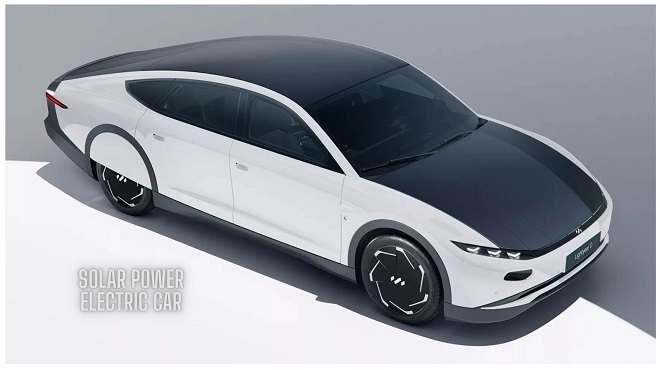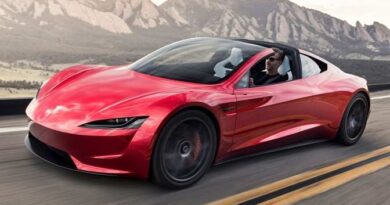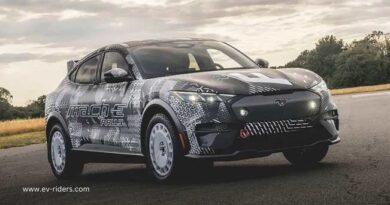Advance Solar Power Electric Car (EV) For $30,000
Advance Solar Power Electric Car (EV) For $30,000
Lightyear launches the world’s first production-ready solar-power electric car Dutch startup Lightyear has unveiled its Light Year Zero Solar power electric car which has 5 curved solar panels integrated into the Light Year Zero cars, roof, bonnet, and tailgate, which will convert renewable solar energy into electric power for driving.

The Solar power electric car would be able to drive while simultaneously charging from sunlight.
After six years of research and development, design, engineering, prototyping, and testing, the solar-powered electric car is slated to go into production in November for $250,000 per unit.
Tests undertaken by Lightyear estimate that the solar cells can add up to 70 days to the car’s 388 miles range from traditional charging in sunny climates such as Spain or Portugal.
The brand said that an average driver covering 35 days could use the car for seven months without it needing to be charged at a public or household outlet.
In colder climates, such as the Netherlands, it could last for two months without needing to be recharged.
Difficulties recharging Solar power electric car and finding convenient and available charging stations is a major reason that discourages consumers from purchasing or using electric cars.
The British government has attempted to counter this problem with legislation that will require all new homes and non-domestic buildings in England to have electric vehicle charging points.
Light Year hopes to combat this with its car that charges while drivers are on the go. The car’s Touchscreen dashboard gives users cloud-based updates, including charging status.
Which solar panels are soaking in the sun’s rays at any given moment?
When plugged into a regular household power socket, drivers can charge over 300 overnight, and Light Year Zero can charge two times faster than a comparable electric vehicle.
With a similar battery size. Measuring 5 meters long and weighing 1575, Solar power electric car has a top speed of 160 km h and can accommodate five passengers.
The electric car’s body is made from panels of reclaimed carbon fiber and aluminum and instead of mirrors, light Year Zero has four cameras one for rearview, one for parking, and two side cameras.
Overall, the electric car has a drag coefficient of less than 00:19, which is extremely low and means that the car consumes less energy and can therefore drive further.
The interior of Light Year Zero is made from vegan and naturally sourced materials such as ecological microfiber, swede seats, and rat and palm detailing.
Lightyear plans to produce 946 solar-power electric car this year and said that its next model, which is being designed for high-volume production in late 2024, will come at a more affordable starting price point of €30,000.
There has been a surge of interest in electric cars that use solar energy. For instance, German car brand Mercedes Benz partnered with the late fashion designer Virgil Abloh on a solar-powered electric car that has a transparent front bonnet.
German company Audi collaborated with Chinese solar cell specialists and develop thin solar panels that can be integrated into car roofs.
Overall, it seems like solar-powered electric cars are slowly but approaching widespread use in the consumer market.
Solar system from the soil
New soil Batteries to Store solar power Underground solar power could be stored in the ground by using Earth’s teeming microbial life to transfer energy.
As a result, UK research and innovation is investing £15 million in this budding technology.
The researchers first got their idea from reading about a concrete battery, which used a chemical process.
That led them to wonder whether a biochemical process might not have more to offer. The plan is to send electricity from solar panels to buried electrodes.
The premise is this if you make energy available to microorganisms, they’ll use it in some way to survive, just like providing food.
If you provide electrical energy, organisms can use it to perform electrosynthesis, where they synthesize carbon-based molecules from carbon dioxide.
It’s akin to photosynthesis, where plants intake CO2 and transform it in their cells. Except, in this case, everything is happening underground instead.
Electric Power Action the microbial life gets to work using the energy to reduce the carbon dioxide to produce a more complex molecule called acetate.
This acetate, which researchers describe as being the same sort of molecule found in vinegar, minus the acid, acts as a chemical store of energy when needed. These feasting microbes release electrons, which flow through the circuit, providing electricity on demand.
Motionless Wind Turbine
New motionless technology harnesses wind energy from rooftops.
University of Houston spinoff era mine technologies has developed a rooftop wind energy system that’s more compact than a typical turbine and works with wind speeds as low as 5 mph.
Whereas traditional small turbines require average wind speeds of at least 9, these units can generate as much power as an array of 16 solar panels while taking up 10% of the roof space.
When manufactured at scale, the system could generate significantly more energy than a rooftop solar panel installation of the same price era.
Mines Wind Energy System doesn’t look anything like a traditional turbine. Instead of spinning blades atop a thin pole, it features a motionless tanklike cylinder that’s linked by airfoils.
As the wind hits the unit’s airfoils, it creates a negative pressure that sucks the wind that’s hitting the building through an internal propeller on the bottom of the unit, which creates energy production connecting directly to the building.
The company envisions 20 to 40 of these units lined up along whichever edge of a rooftop is facing, the direction that gets the most wind, leaving room in the center of the roof for solar panels.
If coupled with solar panels, these wind units provide a path toward achieving onsite energy independence.
Aero Mines Wind Energy System couldn’t be installed on slanted roofs or single-family homes, but it could make onsite wind power generation possible for warehouses, apartment buildings, or other large flat roof structures.
The company has already validated its rooftop wind energy tech through joint research with Sandia National Laboratories and Texas Tech University and expects to have a product ready for the commercial market in 2023.
Related Post



